nForce 500: nForce4 on Steroids?
by Gary Key & Wesley Fink on May 24, 2006 8:00 AM EST- Posted in
- CPUs
Improved Feature: Control Panel / nTune 5.0
One of most interesting features of the nForce 500 launch is the revamped control panel and nTune 5.0 performance applications. NVIDIA has combined all of their various program applets into an integrated control panel to provide a common user interface, a common interface that certainly makes it easier for the user to control the various functions of the board and video (NVIDIA based) from a central point. |
| Click to enlarge |
The new control panel offers configuration sections for 3D Settings for NVIDIA GPUs, Display settings, Networking options, Performance, System Stability testing, Storage, and Video/Television settings. The majority of information contained in each section will already be familiar to those with nForce4 boards, only with the same look and feel as the other control panels as well as some extended configuration options.
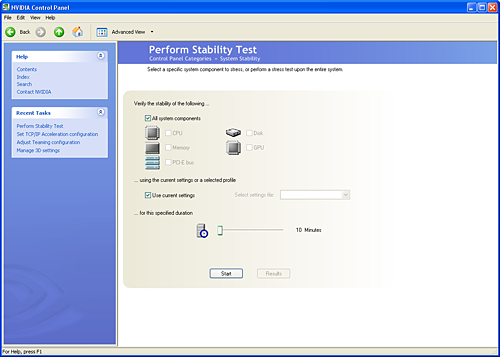 |
| Click to enlarge |
A new application being featured is a System Stability test program that will run application level stress testing on the platform or on an individual component for a user specified amount of time. We found the application would generally fail settings that were a little more conservative than we utilize in stress testing, but it is nice to know the program will err on the safe side.
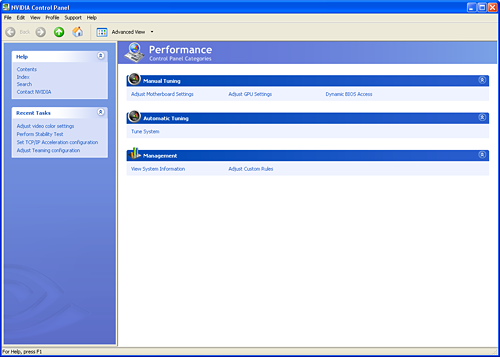 |
| Click to enlarge |
The most interesting application is nTune 5.0 that can be found by clicking the Performance icon. nTune has undergone a complete transform and now includes the ability to dynamically write a significant number of performance settings directly to the BIOS without requiring a reboot. You also have the option for letting the system dynamically create an overclocking profile and automatically adjust the BIOS settings under the Automatic Tuning section.
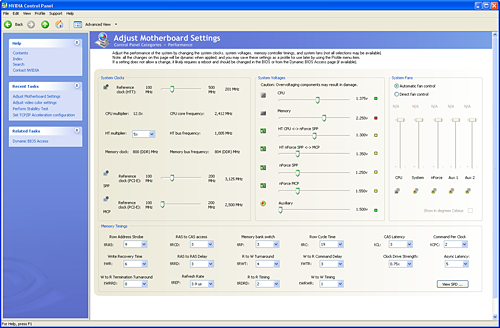 |
| Click to enlarge |
The Adjust Motherboard Settings section is certainly the most interesting of the performance oriented applets as changes in these fields are dynamically written to the BIOS. The settings can be saved in profiles that can be loaded within Windows without having to reset the system and enter the BIOS. This can help with situations where optimal settings for games might differ from those for audio/video playback. The system also allows for automatic or direct fan speed control on supported board headers.
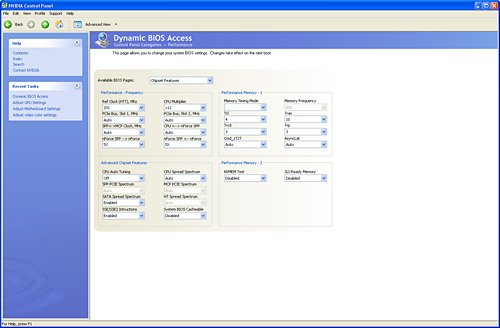 |
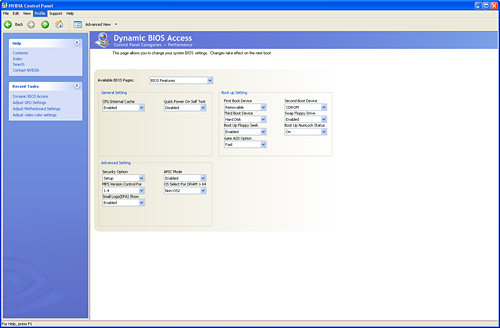 |
| Click to enlarge |
The Dynamic BIOS Access section offers the ability to change BIOS setting in four different categories that will take effect on reboot. The two sections not displayed are for power management and peripheral settings.
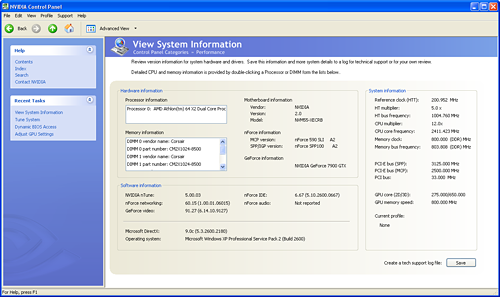 |
| Click to enlarge |
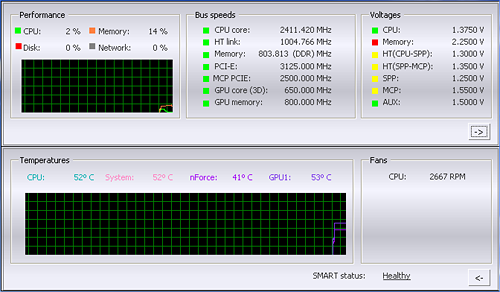 |
NVIDIA also includes a System Information utility along with a Windows based monitoring application. Overall, the polished look, feel, and operation of the new control panel along with the performance improvements offered in nTune 5.0 has raised the bar for user enhancements offered by the core logic and motherboard suppliers.










64 Comments
View All Comments
ayqazi - Wednesday, July 5, 2006 - link
I'm a little tired of hearing about so-called "chipset" hardware RAID. The writer of this article constantly made it seem that it was the chipset that was responsible for performing RAID operations on the disks, whereas nothing could be farther from the truth.Yes, the chipset may offload some of the work, but (in the case of RAID 5) the major calculations, like the XOR calculations, are done by the host processor.
According to [L]http://linuxmafia.com/faq/Hardware/sata.html#faker...[/L] and [L]http://spamaps.org/raidtests.php[/L], Linux-based software raid is much faster than so-called fakeraid, since it has been optimised and developed more than the software drivers of the fakeraid chipsets.
Anyway, just pointing out something that gets on my nerves a bit.
raildogg - Saturday, May 27, 2006 - link
I think for most of us who have a nForce 4 ultras and SLIs, it doesn't make sense to upgrade to AM2 motherboards and processors. We'll need new memory too. No performance increase. Just upgrade to a X2 and that should be a good upgrade for those of us who don't have it yet.Powered by AMD - Friday, May 26, 2006 - link
When in the article says:"In fact, the less than stellar write performance of the nForce4 in RAID 5 continues in the "new" chipset"
It does mean that the write performance is good or not?
thanks!
Zoomer - Saturday, May 27, 2006 - link
Means just as bad as before, in a nicer manner. :)Gary Key - Saturday, May 27, 2006 - link
Thank you for the perfect reply. ;-) NVIDIA is working on this for the next refresh, their reasoning at this time is they did not want to introduce potential data corruption issues by improving the performance with the current chipset and driver base. It continues to reinforce our belief that although the nF590 SLI is the most feature laden chipset out at this time, the core continues to be nForce4 Plus in our eyes. This is not bad at all, just what can you do with a less than stellar CPU release (still an extremely strong CPU lineup) from a marketing viewpoint. I think NVIDIA and ATI are going to be hamstrung on sales with the AM2 release but hopefully they can make it up when Conroe (Core 2 Duo) launches shortly. :) The bios revisions we have received this week have improved performance but nothing that would make a nf4SLI/4800+ owner want to upgrade yet.
SonicIce - Wednesday, May 24, 2006 - link
AM2 can just die.afrost - Thursday, May 25, 2006 - link
i'm glad you took the time to type all that out.....KHysiek - Thursday, May 25, 2006 - link
Well, but it does say precisely right about the whole AM2 transition.This is the most pointless hardware upgrade I've seen forfew last years.
The only significant advantage of AM2 is a bit more featured mainboard. And you pay more for less speed. I think AMD is on the way down and no K8L can save them, cause it will be quad core only. What typical user needs quad core for price AMD keeps (like their pricing for current X2 CPU's versus Intel's).
Core 2 is huge leap forward and combined with Intel manufacturing power will make big push back for AMD in coming months.
Pirks - Wednesday, May 24, 2006 - link
Gary, what's about that QoS network driver/protocol hanging around in my WinXP for years? I heard it does some quality of service stuff/packet prioritizing/etc soo... is FirstPacket just an interface for this Microsoft QoS thing? Or is nVidia didn't know about it and reinvented the wheel?Gary Key - Wednesday, May 24, 2006 - link
I raised this question at the Editor's conference as it appeared to me they decided to take advantage of some hooks/protocols in XP. I have a meeting with the platform manager tomorrow and hopefully some discussions with the Network guru next week after his return from vacation. I am trying to get an answer before our roundup is published. I noticed some interesting inter-actions during our network testing, will say this, they (NVIDIA) really took the networking side seriously on this release although most of the features are designed for the server/workstation market, but we get them for free on the desktop. We expect further hardware/driver improvements in the next refresh. I am trying to compare the outbound FirstPacket numbers to a D-Link Gamer Lounge at this time along with how both prioritize packets on the outbound lanes. There are so many different tests and options in just the new networking features to run that is a bit overwhelming at this point and of course the new draft-N equipment showed up this week also. ;-)